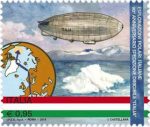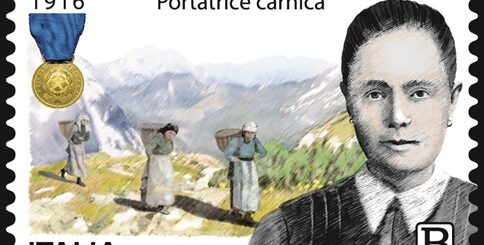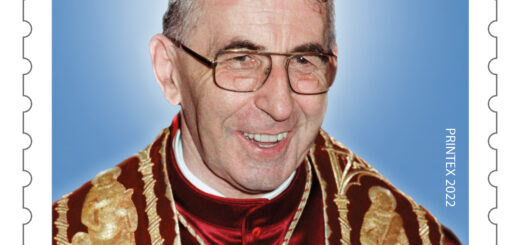POSTE ITALIANE 5^ Emissione del 23 marzo 2018
Titolo: 90° Anniversario della spedizione del Dirigibile Italia al Polo Nord
La spedizione dell’Italia rappresentò il seguito naturale della trasvolata del Norge. Questa trasvolata aveva dimostrato l’efficacia del dirigibile come mezzo di esplorazione, ma dal punto di vista scientifico e cartografico non aveva portato molti risultati: restavano infatti 4 milioni di km² inesplorati nelle regioni artiche. Umberto Nobile iniziò a pensare ad una nuova spedizione non appena il Norge terminò la sua trasvolata in Alaska, ben prima che emergessero le rivalità tra il dirigibilista italiano e l’esploratore norvegese Roald Amundsen sui rispettivi meriti per la trasvolata del Norge.
Nobile pensava di utilizzare un nuovo dirigibile semirigido, l’N-5, con capacità di gas tre volte superiore rispetto a quella del Norge, ma non riuscì a ottenere i fondi per il suo completamento: il governo italiano, e in particolare il Segretario di Stato per la Regia Aeronautica Italo Balbo, erano infatti contrari a nuovi investimenti nel settore dei dirigibili, preferendo dedicarli al settore delle aerodine.
Nobile ripiegò così sul dirigibile N-4, un gemello del Norge, che riuscì a completare con fondi offerti da alcuni industriali e privati della città di Milano: infatti il pubblico italiano aveva accolto con favore la spedizione e appoggi arrivavano anche dal Vaticano, tanto che l’equipaggio fu accolto in udienza dal Pontefice prima della partenza della spedizione. Con i fondi privati venne anche allestita la nave appoggio Città di Milano, un vecchio mercantile il cui comando venne affidato a Giuseppe Romagna, di provata fede fascista. Nobile aveva anche richiesto che due idrovolanti stazionassero presso la Baia del Re per le emergenze, ma Italo Balbo rifiutò anche questa concessione. Venne comunque assegnato un piccolo distaccamento di alpini.
Diversi membri della spedizione del Norge si ritrovarono per la spedizione dell’Italia: Ettore Arduino, Attilo Caratti, Natale Cecioni, Vincenzo Pomella, Renato Alessandrini e il meteorologo svedese Finn Malmgren avevano partecipato alla trasvolata del Norge. Anche Felice Trojani, pur non avendo fatto parte di quell’equipaggio, aveva dato il suo contributo alla precedente spedizione: l’hangar a cielo aperto era infatti un suo progetto. Veterana del precedente volo era anche la fox terrier Titina, inseparabile mascotte di Nobile.
L’Italia partì da Baggio (Milano) il 15 aprile 1928 all’1:55. A bordo vi erano 13 membri dell’equipaggio, 2 giornalisti e 3 scienziati. Il dirigibile giunse alla baia del Re il 6 maggio, dopo due tappe a Stolp in Pomerania e a Vadsø in Norvegia. La fermata di dieci giorni a Stolp fu necessaria per effettuare delle riparazioni per danni da grandine alle superfici di controllo.
Il progetto di Nobile era effettuare 5 voli esplorativi, con partenza e rientro dalla base presso la baia del Re (Ny-Ålesund) nelle Isole Svalbard, in modo da riuscire a coprire diverse aree dell’Artico.
Il primo volo – 11 maggio 1928 Il primo volo si concluse dopo sole 8 ore, a causa dei problemi per la formazione del ghiaccio sui timoni e delle avverse condizioni meteorologiche. Il secondo volo – 15 maggio 1928 Il secondo volo durò circa 3 giorni e furono percorsi 4 000 km. L’esplorazione si mosse verso Nord-Est sorvolando le isole settentrionali della Terra di Francesco Giuseppe arrivando fino a lambire la Terra del Nord (o Severnaja Zemlja, allora chiamata Terra di Nicola II). In totale vennero esplorati 48 000 km² di regioni sconosciute. Vennero compiuti rilievi cartografici su queste regioni, dimostrata l’inesistenza della Terra di Gillis ed effettuate rilevazioni sulla Terra del Nord–Est in cui venne evidenziata l’assenza di ghiacciai. Inoltre venne provato lo scandaglio acustico di tipo Behm per misurare le profondità marine. Fu anche rettificata la posizione dell’Isola Grossa. Il terzo volo e l’incidente – 23/25 maggio 1928 L’obiettivo del terzo volo era di raggiungere il Polo Nord, dove sarebbero dovuti sbarcare alcuni esploratori per effettuare misurazioni sulla banchisa muniti di una tenda e di razioni. Il volo iniziò alle 4:28 del 23 maggio; a bordo erano presenti 16 persone più Titina.
L’involucro del dirigibile con i 6 uomini ancora a bordo non fu mai ritrovato. La posizione dell’impatto era prossima ad 81° 14′ latitudine nord, 28° 14′ longitudine est, a circa 100 km dalle Svalbard. I ghiacci alla deriva portarono i nove sopravvissuti verso le isole Foyn e Broch. Sulla sorte dell’Italia e dei sei uomini rimasti a bordo vi sono due ipotesi: in genere si ritiene che si inabissò nel Mare di Barents; Biagi, Trojani e gli altri superstiti riferirono però, circa mezz’ora dopo l’incidente, di una colonna di fumo all’orizzonte, segno che il dirigibile poteva essere precipitato e aver preso fuoco (o forse il fumo era un’ultima segnalazione degli altri membri dell’equipaggio). Comunque Umberto Nobile riteneva che questa colonna di fumo, per dimensioni e distanza a cui pareva trovarsi, fosse più probabilmente dovuta a uno dei serbatoi di carburante del dirigibile, distaccatosi ed incendiatosi.
Possibili cause Le cause dell’incidente restano tutt’oggi dibattute. I motivi principali furono ovviamente il clima artico e la decisione di tornare alla base, andando così verso la tempesta in peggioramento. È significativo il fatto che questa scelta spinse il meteorologo della spedizione Finn Malmgren quasi sull’orlo del suicidio. Un altro aspetto da considerare tra le possibili cause dell’incidente è la decisione di lasciare risalire il dirigibile sopra lo strato delle nubi, cosa che provocò il riscaldamento dell’involucro, l’espansione dell’idrogeno e il conseguente aumento della pressione, che fece scattare le valvole automatiche liberando il gas. Rientrando in mezzo alle nubi, dopo la riaccensione dei motori, e trovandosi nuovamente ad una temperatura più bassa, l’aeronave iniziò a perdere quota, forse per aver perso troppo gas, oppure perché le valvole automatiche si bloccarono nella posizione aperta per il ghiaccio.
Al suo rientro in Italia, Umberto Nobile fu accusato di imperizia e additato come l’unica causa della sciagura. Interessante, a questo proposito, fu la critica mossagli da Hugo Eckener: secondo il grande capitano di Zeppelin tedesco, Nobile non avrebbe mai dovuto far risalire l’Italia sopra le nuvole. Tuttavia, sia Nobile che Trojani e i sopravvissuti al disastro, durante la permanenza sul pack e successivamente, cercarono una spiegazione tecnica logica. Ne trovarono oltre 11, ma nessuna di esse sembrava plausibile e poté essere mai dimostrata. Molto probabile, più della dilatazione dell’idrogeno, che data la grande massa era difficile da riscaldare nel breve tempo di permanenza sopra le nubi, poteva risultare il cedimento strutturale dell’involucro, che prima della partenza, all’interno dell’hangar, era stato sottoposto alla rimozione della neve caduta, con attrezzi poco adatti e scarponi chiodati.
| data /date | 23.03.2018 |
| n. catalogo – n. catalog | Michel 4036 – YT 3797 – Un. 3879 – Sn. 3503 |
| dentellatura/Serration | 11 |
| stampa/printing | rotocalco |
| tipo di carta/paper type | bianca patinata neutra |
| stampato | I.P.Z.S. Roma |
| fogli/sheet | 28 |
| dimensioni/dimensions | 48 x 40mm |
| disegnatore /designer | I. Castellana |
| tiratura | 400.000 |
Title: 90° Anniversary of the expedition of the dirigibile ITALIA to the North Pole
The shipment of the Italy represented the natural consequence of the flight of the Norge. This flight had demonstrated the efficacy of the airship as a means of exploring, but from the point of view of scientific and cartographic had not brought many results: remained in fact 4 million km² unexplored in arctic regions. Umberto Nobile began to think about a new shipment as soon as the Norge ended its flight in Alaska, well before that reveals the rivalry between the dirigibilista Italian and Norwegian explorer Roald Amundsen on the respective merits for the flight of the Norge.
Noble thought to use a new semi-rigid airship, the N-5, with the gas capacity three times higher than that of the Norge, but it was not able to obtain the funds for its completion: the Italian Government, and in particular the Secretary of State for the Regia Aeronautica Italo Balbo, were in fact opposed to new investments in the sector of airships, preferring dedicated them to the field of aircraft.
Noble refolded so on airship n-4, a twin of the Norge, who managed to complete with funds offered by certain industrial and private of the city of Milan: in fact the italian audience had welcomed the shipment and supports also arrived from the Vatican, so much so that the crew was received in audience by the Pope before the departure of the consignment. With the private funds was also set up the support ship City of Milan, an old merchant whose command was entrusted to Giuseppe Romagna, of proven faith fascist. Noble had also requested that two seaplanes stazionassero at bay of the King for emergencies, but Italo Balbo refused even this concession. Was still awarded a small outpost of the alpini. Several members of the expedition of the Norge is convened for the dispatch of Italy: Ettore Arduino, Attilo Caratti, Christmas Cecioni, Vincenzo Pomella, Renato Alessandrini and the meteorologist Swedish Finn Malmgren had participated in the Flight of the Norge. Also Happy Trojani, despite not having been part of that crew, had given its contribution to the previous dispatch: the hangar to open sky was in fact his project. Veteran of the previous flight was also the fox terrier Titina, inseparable mascot of noble.
Italy departed from Baggio (Milan) on 15 April 1928 at 1:55. On board there were 13 Members of the crew, 2 journalists and 3 scientists. The airship came to the bay of King on 6 May, after two stages Stolp Pomerania and Vadsø in Norway. The stop for ten days at Stolp was required to carry out repairs for hail damage control surfaces.
The project of the noble was make 5 exploratory flights, with departure from and return from the base at the bay of the King (Ny Ålesund-) in the Svalbard Islands, in order to be able to cover different areas of the Arctic.
The first flight – 11 May 1928 The first flight ended after only 8 hours, because of the problems for the formation of ice on the rudders and adverse weather conditions. The second flight – 15 May 1928 The second flight lasted about 3 days and were paths 4 000 km. The exploration moved toward the North-East flying over the northern islands of the earth of Francesco Giuseppe coming up to strike the land of the North (or Severnaja Zemlja, then call the Earth of Nicholas II). In total were explored 48 000 km² of unknown regions. Were made cartographic projections on these regions, demonstrated the non-existence of the Land of Gillis and made observations on the land of the north-east in which was highlighted the absence of glaciers. It was also tested the sounding alarm Behm type to measure the depths of the sea. It was also corrected the location of the island Grossa. The third flight and the accident – 23/25 May 1928 the objective of the third flight was to reach the North Pole, where they would land some explorers to carry out measurements on the ice equipped with a tent and rations. The flight began at 4:28 23 May; onboard there were 16 people more Titina.
The casing of the airship with the 6 men still on board was never found. The position of the impact was close to 81° 14′ north, 28° 14′ east longitude, approximately 100 km from Svalbard. Ice adrift brought the nine survivors toward the islands Foyn and Broch. On the fate of Italy and of the six men remained on board there are two hypotheses: it is generally believed that you inabissò in the Barents Sea; Biagi, Trojani and the other survivors told however, about half an hour after the incident, a column of smoke on the horizon, a sign that the airship could be precipitated and have taken to fire (or perhaps the smoke was a final reporting of other crew members). However Umberto Nobile believed that this column of smoke, for size and distance at which seemed to be, was most likely due to one of the fuel tanks of the airship, which have come away and incendiatosi.
Possible causes the causes of the accident are still debated. The main reasons were obviously the arctic climate and the decision to return to base, thus going toward the storm in worsening. It is significant that this choice impelled the meteorologist of shipping Finn Malmgren almost on the verge of suicide. Another aspect to be considered among the possible causes of the accident is the decision to leave trace the airship over the layer of clouds, which provoked the heating of the casing, the expansion of the hydrogen and the consequent increase in pressure that did take the automatic valves thereby freeing the gas. Returning in the midst of the clouds, after the restart of the motors, and being again to a lower temperature, the airship began to lose altitude, perhaps for having lost too much gas, or because the automatic valves it froze in the open position for the ice.
On his return to Italy, Umberto Nobile was accused of incompetence and pointed out as the sole cause of the disaster. Interesting in this regard was the criticism mossagli by Hugo Eckener: according to the great captain of the Zeppelin German, Noble would never have had to climb the Italy above the clouds. However, both noble that Trojani and survived the disaster, during the stay on the pack and subsequently sought a technical explanation logic. It found over 11, but none of them seemed plausible and could never be demonstrated. Very likely, more of the dilation of the hydrogen, that given the large mass was difficult to heat in the short residence time above the clouds, could be the structural collapse of the casing, that before departure, inside the hangar, was subjected to the removal of snow fall, with implements ill-suited and studded boots.







